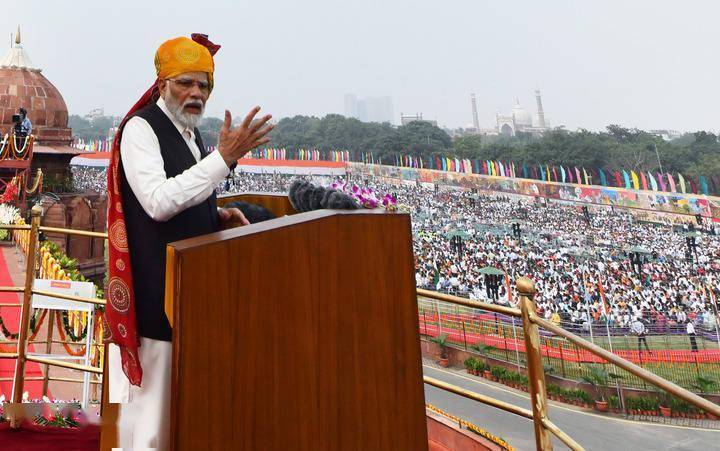
參考消息網9月5日報道香港《南華早報》網站8月18日刊發題為《忘記主宰世界吧,印度不會很快趕上中國》的文章,作者為美國布魯金斯學會約翰·桑頓中國中心高級研究員、戰略通路谘詢公司首席執行官杜大偉。全文摘編如下:
去年,印度總理納倫德拉·莫迪在慶祝印度從英國統治下獲得獨立75周年之際,呼籲印度“主宰世界”。
他的“改革、執行、轉型”口號包含著遠大的夢想。他可能夢想著1870年之前的光輝歲月——當時印度和中國是世界上最強大的兩個經濟體。
但夢想並不能製訂計劃。莫迪上台以來推動印度躋身世界最強大經濟體之列的計劃,在很大程度上仍然隻是計劃。
美國哈佛大學教授格雷厄姆·艾利森最近在《外交政策》上發表的一篇文章中提醒我們,大約十年前,新加坡開國總理李光耀曾說過,印度永遠趕不上中國,將永遠是“未來之國”。李光耀說,“不要把印度和中國混為一談”——這是在向某些人提出反對意見,他們認為印度正在追擊中國並為印度加油打氣,希望印度能夠遏製中國的崛起。
公平地說,在經曆了幾十年的停滯和失望之後,莫迪政府的經濟表現值得尊敬。自2014年以來,印度的國內生產總值平均每年增長約6%,去年更是達到9.1%——在新冠疫情和世界許多地區經濟衰退的動蕩形勢下,印度的表現令人印象深刻。
但是,印度要想擺脫過去的經濟桎梏,還需要進行廣泛的結構性改革。這些桎梏包括種姓製度的束縛,官僚主義的摩擦,難以逾越的稅收規則,仍難以根除的對地方商業巨頭的保護,以及高於世界絕大多數國家的進口關稅。
任何一個從如此低的基礎上崛起的國家都必須認識到,要實現李光耀眼中那種與中國平起平坐的目標還需要幾十年的時間,而這並不是什麽可恥的事情。
高盛集團上個月預測,到2075年,中國將成為世界上最大的經濟體,而印度將超過美國。
哥倫比亞大學經濟學家阿爾溫德·帕納加裏亞也有類似預測。他最近在《時代》雜誌上計算,如果到本世紀40年代印度的實際國內生產總值每年增長8%,之後增長5%,而美國繼續保持平均每年增長2%,那麽印度將在2073年超過美國。
這些如果都是很大的假設,即使對那些敢於預測半個世紀後情況的人來說也是如此。而大量數據表明,印度將走出一條更為平淡的發展軌跡。
印度需要連續多年優異的經濟增長才能開始在經濟重要性上與中國相匹敵,而任何奇跡般的想法或者“中國+1”的投資戰略都不可能加快這一進程。
21世紀可能不是印度的世紀,但幾乎可以肯定是亞洲的世紀。華盛頓需要接受這一點,也許新德裏也需要接受這一點。
- Even the most India-positive forecasts expect it to spend half a century to overtake the US economically, to take second place behind China
- India’s policymakers should focus instead on opening up their economy and recognising that it can still be a huge driver in the global economy
His “reform, perform, transform” mantra involves dreaming big. He was possibly dreaming of those halcyon days up to 1870 when India and China counted as the world’s two largest and most powerful economies.
But a dream does not make a plan. And in the nine years since Modi came to power, his plans to propel India to the top table of the world’s most powerful economies remain largely that – plans.
To be fair to Modi, his government’s economic performance is respectable after decades of stagnation and disappointment. India’s gross domestic product has grown by about 6 per cent every year on average since 2014, reaching an all-time high of 9.1 per cent last year – impressive in light of the upheavals of the Covid-19 pandemic and recession in many parts of the world.

Columbia University’s Arvind Panagariya has similar projections, calculating recently in Time magazine that if India’s real GDP grew at 8 per cent a year into the 2040s and 5 per cent after that, and if the US continues to grow on average by 2 per cent a year, India would overtake the US in 2073.
These are big “ifs”, even for those brave enough to make forecasts a half-century away. And huge bodies of data point India towards a more humdrum trajectory. According to Allison in Foreign Policy, back in 2000, China and India had economies worth less than US$2 trillion each. It took China five years to pass the mark and India 14 years. Last year, India’s economy was worth US$3.4 trillion – a fraction of China’s US$18.3 trillion.
Also, many other important economic indicators remain problematic. India accounted for about 1 per cent of global manufacturing in 2000, compared with 7 per cent for China. By last year, India’s share had grown to 3 per cent against China’s 31 per cent. In 2000, India accounted for just 1 per cent of the world’s exports, and China 2 per cent. By last year, China accounted for 15 per cent of global exports against India’s share of 2 per cent.

Allison reminds us that China produces twice as many STEM-qualified (in science, technology, engineering and mathematics) graduates as India, spends almost three times the percentage of its GDP on research and development, and produces 65 per cent of the world’s artificial intelligence patents (vs India’s 3 per cent).
As Bloomberg noted in April: “India is far behind China in key aspects important for manufacturing that include infrastructure, bureaucracy, attention to detail and even a sense of urgency.”
They have ignored the withdrawals of companies like the Royal Bank of Scotland, Harley-Davidson and Citibank, and the many other companies with plans on hold. They have tended to celebrate the deliberate obstacles to prospective investment in China, even where China is a natural partner and the benefit of collaboration is huge.
Rather than harbouring dreams of dominating the world, India’s policymakers would benefit us all by opening up their economy and recognising that even if India does not surpass China, it can still be a huge driver in the global economy. China and India together account for one third of the world’s population, one third of the global consumer class, and a quarter of all consumer spending in purchasing power parity terms.
The 21st century may not be India’s century, but it is almost certainly Asia’s. Washington needs to come to terms with that, and perhaps New Delhi does too.
David Dodwell is CEO of the trade policy and international relations consultancy Strategic Access, focused on developments and challenges facing the Asia-Pacific over the past four decades.





